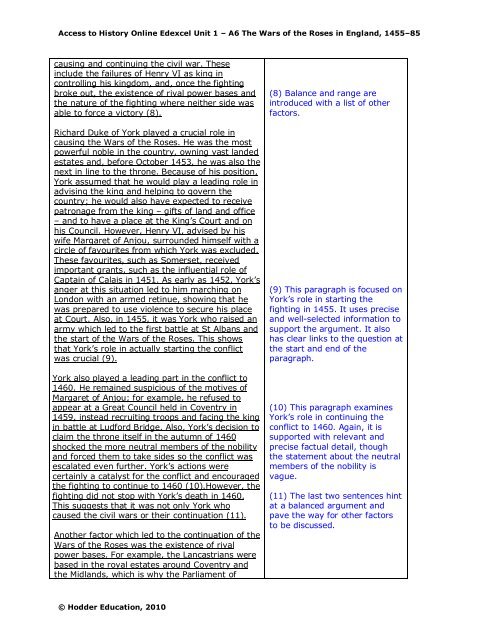Edexcel – Unit 1 - Access to History 2
Edexcel – Unit 1 - Access to History 2
Edexcel – Unit 1 - Access to History 2
You also want an ePaper? Increase the reach of your titles
YUMPU automatically turns print PDFs into web optimized ePapers that Google loves.
<strong>Access</strong> <strong>to</strong> His<strong>to</strong>ry Online <strong>Edexcel</strong> <strong>Unit</strong> 1 – A6 The Wars of the Roses in England, 1455–85causing and continuing the civil war. Theseinclude the failures of Henry VI as king incontrolling his kingdom, and, once the fightingbroke out, the existence of rival power bases andthe nature of the fighting where neither side wasable <strong>to</strong> force a vic<strong>to</strong>ry (8).Richard Duke of York played a crucial role incausing the Wars of the Roses. He was the mostpowerful noble in the country, owning vast landedestates and, before Oc<strong>to</strong>ber 1453, he was also thenext in line <strong>to</strong> the throne. Because of his position,York assumed that he would play a leading role inadvising the king and helping <strong>to</strong> govern thecountry; he would also have expected <strong>to</strong> receivepatronage from the king – gifts of land and office– and <strong>to</strong> have a place at the King’s Court and onhis Council. However, Henry VI, advised by hiswife Margaret of Anjou, surrounded himself with acircle of favourites from which York was excluded.These favourites, such as Somerset, receivedimportant grants, such as the influential role ofCaptain of Calais in 1451. As early as 1452, York’sanger at this situation led <strong>to</strong> him marching onLondon with an armed retinue, showing that hewas prepared <strong>to</strong> use violence <strong>to</strong> secure his placeat Court. Also, in 1455, it was York who raised anarmy which led <strong>to</strong> the first battle at St Albans andthe start of the Wars of the Roses. This showsthat York’s role in actually starting the conflictwas crucial (9).York also played a leading part in the conflict <strong>to</strong>1460. He remained suspicious of the motives ofMargaret of Anjou; for example, he refused <strong>to</strong>appear at a Great Council held in Coventry in1459, instead recruiting troops and facing the kingin battle at Ludford Bridge. Also, York’s decision <strong>to</strong>claim the throne itself in the autumn of 1460shocked the more neutral members of the nobilityand forced them <strong>to</strong> take sides so the conflict wasescalated even further. York’s actions werecertainly a catalyst for the conflict and encouragedthe fighting <strong>to</strong> continue <strong>to</strong> 1460 (10).However, thefighting did not s<strong>to</strong>p with York’s death in 1460.This suggests that it was not only York whocaused the civil wars or their continuation (11).Another fac<strong>to</strong>r which led <strong>to</strong> the continuation of theWars of the Roses was the existence of rivalpower bases. For example, the Lancastrians werebased in the royal estates around Coventry andthe Midlands, which is why the Parliament of(8) Balance and range areintroduced with a list of otherfac<strong>to</strong>rs.(9) This paragraph is focused onYork’s role in starting thefighting in 1455. It uses preciseand well-selected information <strong>to</strong>support the argument. It alsohas clear links <strong>to</strong> the question atthe start and end of theparagraph.(10) This paragraph examinesYork’s role in continuing theconflict <strong>to</strong> 1460. Again, it issupported with relevant andprecise factual detail, thoughthe statement about the neutralmembers of the nobility isvague.(11) The last two sentences hintat a balanced argument andpave the way for other fac<strong>to</strong>rs<strong>to</strong> be discussed.© Hodder Education, 2010
















